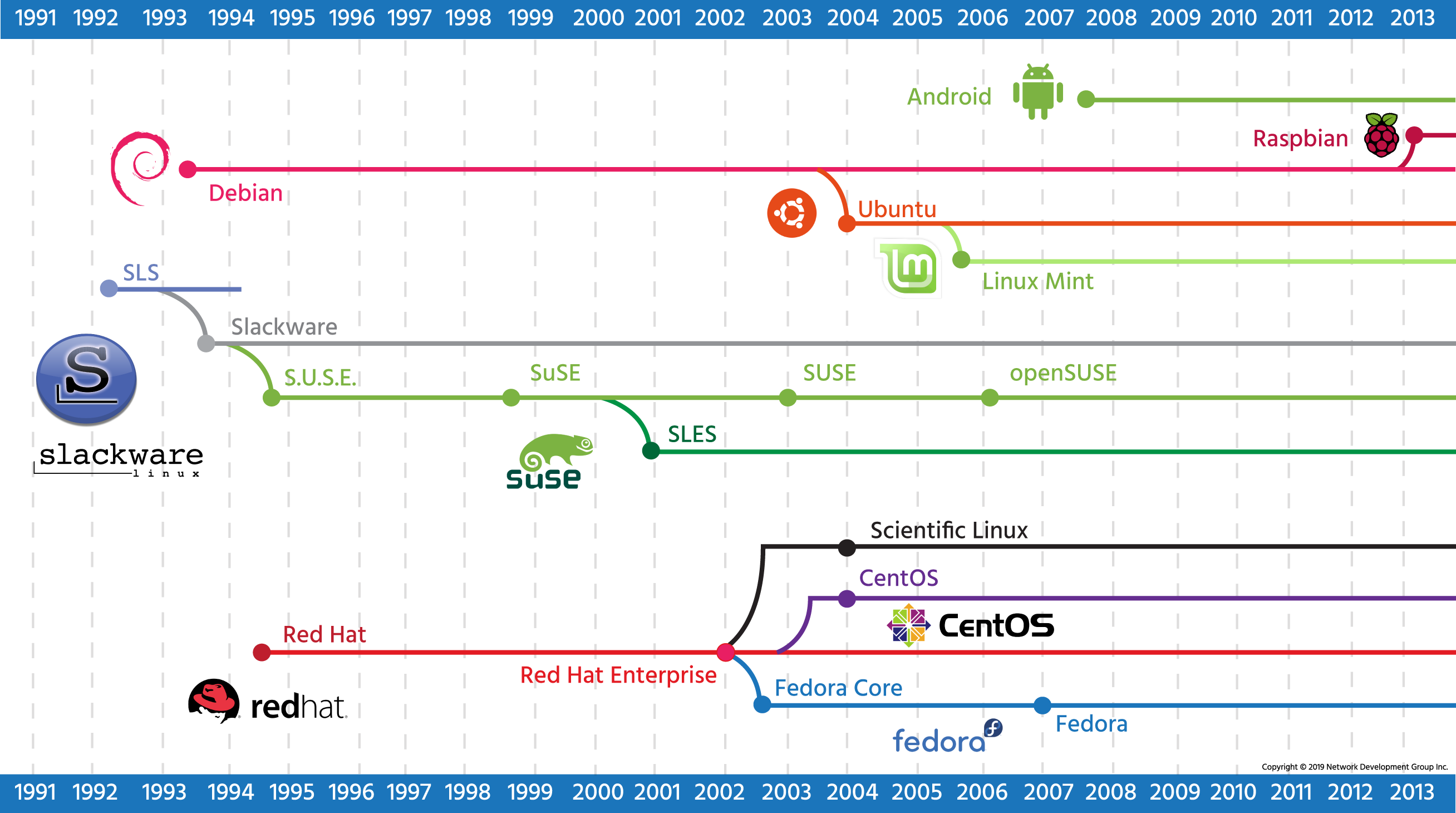2.4.1 Linux Distributions
Red Hat
Red Hat started as a simple distribution that introduced the Red Hat Package Manager (RPM). The developer eventually formed a company around it, which tried to commercialize a Linux desktop for business. Over time, Red Hat started to focus more on the server applications, such as web- and file-serving and released Red Hat Enterprise Linux (RHEL), which was a paid service on a long release cycle. The release cycle dictates how often software is upgraded. A business may value stability and want long release cycles, while a hobbyist or a startup may want the latest software and opt for a shorter release cycle. To satisfy the latter group, Red Hat sponsors the Fedora Project which makes a personal desktop comprising the latest software but is still built on the same foundations as the enterprise version.
Because everything in Red Hat Enterprise Linux is open source, a project called CentOS came to be. It recompiled all the RHEL packages (converting their source code from the programming language they were written into language usable by the system) and gave them away for free. CentOS and others like it (such as Scientific Linux) are largely compatible with RHEL and integrate some newer software, but do not offer the paid support that Red Hat does.
Scientific Linux is an example of a specific-use distribution based on Red Hat. The project is a Fermilab-sponsored distribution designed to enable scientific computing. Among its many applications, Scientific Linux is used with particle accelerators including the Large Hadron Collider at CERN.
SUSE
SUSE, originally derived from Slackware, was one of the first comprehensive Linux distributions, it has many similarities to Red Hat Enterprise Linux. The original company was purchased by Novell in 2003, which was then purchased by the Attachmate Group in 2011. The Attachmate group then merged with Micro Focus International in 2014, and in 2018 SUSE announced plans to go forward as an independent business. Through all of the mergers and acquisitions, SUSE has managed to continue and grow.
While SUSE Linux Enterprise contains proprietary code and is sold as a server product, openSUSE is a completely open, free version with multiple desktop packages similar to CentOS and Linux Mint.
Debian
Debian is more of a community effort, and as such, also promotes the use of open source software and adherence to standards. Debian came up with its own package management system based on the .deb file format. While Red Hat leaves non-Intel and AMD platform support to derivative projects, Debian supports many of these platforms directly.
Ubuntu is the most popular Debian-derived distribution. It is the creation of Canonical, a company that was made to further the growth of Ubuntu and makes money by providing support. Ubuntu has several different variants for desktop, server and various specialized applications. They also offer an LTS version that is kept up-to-date for 3 years on desktops and 5 years on servers, which gives developers and the companies they work for confidence to build solutions based on a stable distribution.
Linux Mint was started as a fork of Ubuntu Linux, while still relying upon the Ubuntu repositories. There are various versions, all free of cost, but some include proprietary codecs, which cannot be distributed without license restrictions in certain countries.
Android
Linux is a kernel, and many of the commands covered in this course are actually part of the GNU package. That is why some people insist on using the term GNU/Linux instead of Linux alone.
Android, sponsored by Google, is the world’s most popular Linux distribution. It is fundamentally different from its counterparts. Android uses the Dalvik virtual machine with Linux, providing a robust platform for mobile devices such as phones and tablets. However, lacking the traditional packages that are often distributed with Linux (such as GNU and Xorg), Android is generally incompatible with desktop Linux distributions.
This incompatibility means that a Red Hat or Ubuntu user cannot download software from the Google Play store. Likewise, a terminal emulator in Android lacks many of the commands of its Linux counterparts. It is possible, however, to use BusyBox with Android to enable most commands to work.
Other
Raspbian is a specialized Linux distribution optimized to run on Raspberry Pi hardware. This combination has seen significant use in training for programmers and hardware designers at all levels. Its low cost and ease of use have made it a favorite of educators worldwide, and many add-on devices are available to extend its capabilities into the physical world. There is a multitude of labs and projects available that teach everything from environmental monitoring to circuit design, machine learning, and robotics.
Linux From Scratch (LFS) is more of a learning tool than a working distribution. This project consists of an online book, and source code, with “step-by-step instructions” for building a custom Linux distribution from the source code up. This “distribution” embodies the true spirit of Linux whereby users can modify any aspect of the operating system and learn how all the pieces work together. It’s also a good starting point for anyone who needs specialized functionality or an ultra-compact build for an embedded system project.
We have discussed the distributions explicitly mentioned in the Linux Essentials objectives. Be aware that there are hundreds, if not thousands more that are available. While there are many different distributions of Linux, many of the programs and commands remain the same or are very similar.
